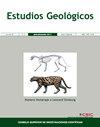Suidos fósiles del Sistema paleokárstico de Bolt's Farm, Sudáfrica: implicaciones para la taxonomía y biocronología de Potamochoeroides y los Notochoerus
IF 0.8
4区 地球科学
Q3 GEOLOGY
引用次数: 2
Abstract
Recent excavations at Aves Cave I (AC), Brad Pit ‘A’ (BPA), Milo ‘A’ (MA), Bridge Cave (BC) and Alcelaphine Cave (AL), in the Cradle of Humankind, Gauteng, South Africa, have yielded fossil suid remains which provide biostratigraphic information about the periods of deposition in the Bolt’s Farm Palaeokarst System. At Aves Cave I there are Late Pliocene deposits which have yielded the extinct suid Potamochoeroides hypsodon , including skeletal elements that were poorly represented in previous collections from Bolt’s Farm as well as rare remains of Notochoerus capensis . At Brad Pit ‘A’ remains of Gerontochoerus koobiforaensis occur. Milo ‘A’ and other deposits have yielded remains of the suid Metridiochoerus andrewsi that indicate a later phase of endokarst sedimentation (Early Pleistocene). The Panthera Spot at Bridge Cave has yielded articulated foot bones of a suid, provisionally identified as Phacochoerus modestus and which suggest an Early Pleistocene age for this infilling. The augmented samples of suids from Bolt’s Farm invite detailed comparisons with the Suidae from Makapansgat which permits a review of the taxonomy of Notochoerus and Potamochoeroides . It is shown that both genera are Suinae, and could be synonyms. Comparisons are also made with Plio-Pleistocene suids from Malawi and Namibia.南非博尔特农场古喀斯特系统的Suidos化石:对Potamochoeroides和Notochoerus分类学和生物年代学的启示
最近在南非豪登省人类摇篮的avescave I (AC), Brad Pit ' A ' (BPA), Milo ' A ' (MA), Bridge Cave (BC)和Alcelaphine Cave (AL)的挖掘工作中,发现了化石液体残骸,这些化石液体残骸提供了关于Bolt ' s Farm古火山岩系统沉积时期的生物地层学信息。在avesi洞穴,有上新世晚期的沉积物,其中发现了已经灭绝的suamochoeroides hypsodon,包括博尔特农场以前收集的很少代表的骨骼元素,以及罕见的capensis Notochoerus的遗骸。在Brad Pit ' A '出现了koobiforaensis的Gerontochoerus遗骸。Milo ' A '和其他矿床已经发现了Metridiochoerus andrewsi的残骸,表明喀斯特内沉积的后期(早更新世)。桥洞的Panthera Spot发现了一种水龙的关节足骨,暂时被鉴定为Phacochoerus modestus,这表明这种填充物的时代是早更新世。来自博尔特农场的增加的水蛭样本可以与来自马卡潘斯加特的水蛭科进行详细的比较,从而可以对Notochoerus和Potamochoeroides的分类进行回顾。结果表明,这两个属都是水獭科,可能是近义词。并与马拉维和纳米比亚的上新世-更新世水样进行了比较。
本文章由计算机程序翻译,如有差异,请以英文原文为准。
求助全文
约1分钟内获得全文
求助全文
来源期刊

Estudios Geologicos-Madrid
GEOLOGY-
CiteScore
1.40
自引率
14.30%
发文量
6
审稿时长
>12 weeks
期刊介绍:
Since 1945 Estudios Geologicos publishes original research works, as well as reviews, about any topic on Earth Sciences.
Estudios Geologicos is published as one yearly volume, divided into two half-yearly issues. It is edited by the Spanish National Research Council (Consejo Superior de Investigaciones Científicas, CSIC) at the Instituto de Geociencias (CSIC-UCM).
Estudios Geologicos provides free access to full-text articles through this electronic edition. Accepted articles appear online as "Forthcoming articles" as soon as the galley proofs have been approved by the authors and the Editor-in-Chief. No changes can be made after online publication.
 求助内容:
求助内容: 应助结果提醒方式:
应助结果提醒方式:


